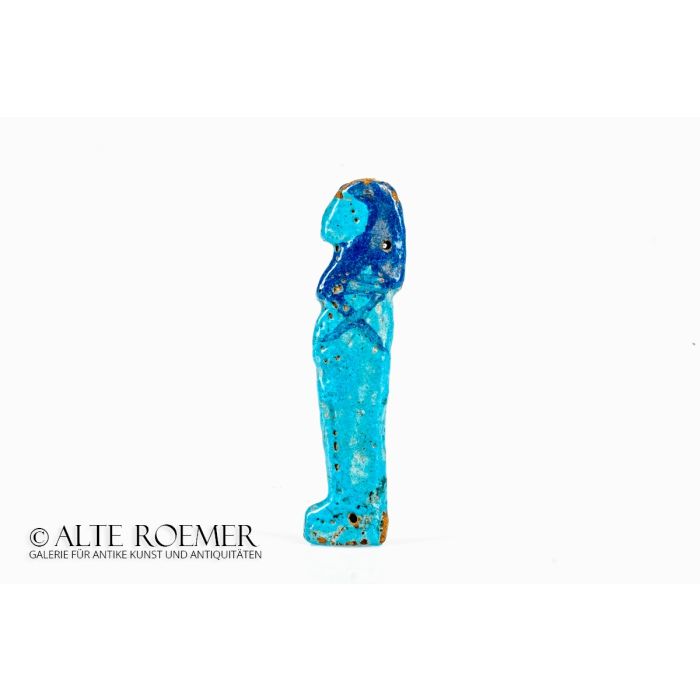Appliqué of the Horus Son Imsety
Price: on request
Sold
Object number
AR3023A
| Object: |
Appliqué of the Horus Son Imsety
|
| Material: |
Turquoise faience over red clay core with additional blue glaze.
|
| Period: |
30th dynasty of the Late Period to early Ptolemaic period. Circa 380 BC to 150 BC. |
| Description: |
Beautiful bichrome faience appliqué of the Horus Son Imsety. The concave surface shows the god standing to the left. The rear side is flat. The amulet has two holes to stich it to the mummy bandage or to be included in a net of beads placed over the mummy's breast.
|
| Background: |
In ancient Egyptian mythology, the god Horus had four sons with Isis - Imsety, Duamutef, Hapi and Qebehsenuef. They are best known as the protectors of the organs taken from the mummy. Every lover of Egyptian art knows the so-called canopic jars. These are sets of four vessels whose lids are decorated with the heads of the Horus children. Since the Third Intermediate Period, however, the organs have no longer been placed in canopic jars, but have been prepared and embalmed and returned to the body of the deceased. In place of the canopic lids, the Horus children now appeared in the form of appliqués, such as this one. The appliqués were usually placed on the mummy together with a winged scarab, so that the amulets of the four children lay out in pairs and the heads looked at each other. The appliqués were provided with holes through which they were sewn to the mummy bandage or woven in a support of beads. The Imsety figure offered here had certainly this function. Together with its siblings it protected and accompanied the deceased. The protective god Imsety was responsible for the liver. |
| Dimensions: |
9.9cm height.
|
| Condition: |
Near perfect preservation, only minor wear of the beautiful bichrome faience. Remains of a sticker on the rear side and red inscription "EG[or Q]29.1777" (inventory no. of the Newark Museums). Including tag reading "Transfer Classical Collection PC.7/13/87" and "Faience Osiris X00.16d".
|
| Provenance: |
Acquired by us in 2020 from an US American auction house. Consigned by the US American Newark Museum of Art. The figurine was included in the museum collection in 1929 as inventory number "EG/Q29.1777". It was transferred to the educational lending collection in 1987. A museum tag from this time comes with the figurine.
|
| Literature: |
C. Andrews, Amulets of ancient Egypt, p. 45f.
|
| Authenticity: |
We unconditionally guarantee the authenticity of every artefact, all items are subject to our lifetime return policy on authenticity.
|


